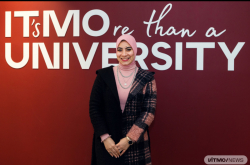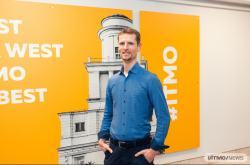You came to St. Petersburg from Tanzania. What were you working on back home?
Generally, my specialization covers two fields. The first is the management and optimization of traditional and green resources of electrical power, including with the aid of artificial intelligence. The second deals with electric cars and electric engines.
Working with technology is my passion. It’s difficult to control systems that can’t even speak. It starts with understanding how a specific device works, or how an electrical network is set up. Then, you develop a set of instructions that make them perform certain tasks like a human being, and such achievements bring joy to me.
To acquire my specialization in electrical engineering, I graduated with a Bachelor’s from the University of Dar es Salaam (UDSM) in the Tanzanian capital. Then, I enrolled at Dongguk University (South Korea), where I studied in a combined Master’s and PhD program. After that, I went back home, where I continued to teach and supervise students’ graduate projects, as well as conduct research with scientists from around the world.
Then, I joined the University of Pretoria (South Africa) for my postdoctoral research fellowship. There, my colleagues and I worked on a new – efficient, reliable, and sustainable – renewable source-based electrification system for remote rural areas. I also worked with researchers from University of Cambridge on low-cost power converters for autonomous solar photovoltaic (PV) systems.
Jackson J. Justo. Photo by Dmitry Grigoryev / ITMO.NEWS
As I understand, you’ve worked with universities not only in South Korea, but in Germany, Indonesia, and Sweden, as well. How did you manage to work in all these places? And what did that experience bring you?
For that, you’d have to thank my research supervisor from Dongguk University. During my studies there, every two days there’d be a seminar where we presented the results of our work as scientific papers. My supervisor was very demanding and would make me re-draft these texts until they were perfect. And even if I sent it for checking at midnight, in half an hour I would get a message back saying what I need to fix.
It must be said that we only published papers in highly cited Q1 journals. To achieve that, one had to work even harder – sometimes, it involved rewriting an article up to 20 times so that it would get accepted. Of course, after such effort, it would be very difficult to receive a rejection from the editor. It was, in a way, like running a marathon: you’re out of strength and will, and it seems as if you can’t run any further, but your coach (in this case – supervisor) is shouting that you must go on and overcome these obstacles to become a better person in your research field. And gradually, you began to succeed. Now, looking back on my experience, I would advise young scientists to go “past the flags” and build a long-term strategy: keep working despite the rejections and learn to perceive criticism as a part of the learning process through which you become a better person.
I remained in this mode for five years, and it wasn’t for nothing. After publishing my first paper in a Q1 journal, I became aware of what it takes to publish articles in high-impact journals. In fact, it is all about learning to accept criticisms and understanding how to avoid the same mistakes.. In a nutshell, at first it takes a day or more to conceptualize an idea and later it becomes an easy task as time goes on. Thus, I think it’s great for someone to have other skills that allow them to represent idea in a simple or complex way.Through publishing high impact articles, it is easy to gain the trust of other researchers with similar interests: when they see your work in a highly cited journal, they know it’s been carefully crafted and there’s no “filler” in it, and that means it can be cited. Currently, I am the editor and technical reviewer of several international scientific journals published by the world’s largest engineering associations like IEEE (Institute of Electrical and Electronics Engineers) and IET (Institute of Engineering and Technology).
Thanks to such publications in top-ranked journals, more people began to notice my work and invite me to collaborate on teaching and research projects at various universities around the world. That’s how someone can be rewarded in research and development. If you can get a patent and license in industry, it is much better as it gives more relevance to your work. In my case, I have two patents and one under evaluation; I hope that one or two will be commercialized and start producing royalties.
Jackson J. Justo. Photo by Dmitry Grigoryev / ITMO.NEWS
And how did your partnership with ITMO begin?
The story is quite similar. In 2023, I planned to take a creative break and was looking for a place where I could travel, avoid the routine, and, perhaps, get into new research activities. Fortunately, I received an invitation to join the ITMO Fellowship program. I like Russia and I’ve heard a lot about it through Russian and Western media, but I’d wanted to see it for myself. So, when I got the invitation letter, I decided this was fate – and, since July, I’ve been here comfortably working and trying to achieve something to remember.
I am also looking to establish a strong collaboration between ITMO University and University of Dar es Salaam and, potentially, launch my own laboratory at ITMO or UDSM. I believe that with such a laboratory, Russian and Tanzanian students would be able to work on various joint research projects and go on semester exchange.
What has been your impression of Russia “in person?” What surprised you the most here?
I arrived in July 2024 and it was the beginning of the summer. During that time, the weather is very similar to my city (Dar es Salaam) and there is also no time difference – hence, no need to change my clock. However, the shorter nights and longer days were a nice experience. Moreover, I found Russia to be quite a nice place to live and work. In fact, people are very welcoming and ready to offer help whenever someone asks something, which is very important for foreigners like me. This strongly encourages me to recommend it to anyone who wishes to visit Russia for work.
Jackson J. Justo. Photo by Dmitry Grigoryev / ITMO.NEWS
And what is your current research at ITMO about?
My current research is about combining traditional and green energy resources into a shared power system and managing it with the help of AI tech. Conventional energy resources, such as gas, oil, coal, or wood, have two issues: they are neither renewable nor environmentally friendly. That’s why we’re looking into other – cheap and emission-free – energy resources, like solar, wind, biomass (organic waste), or green hydrogen.
Imagine that you have all these sources of green energy and they’re enough to power the whole house – and maybe even have a little left over. Or, conversely, your own generators aren’t enough and you need an additional source of power. What do you do in this case? That’s when selling and buying electricity becomes possible. Even now, countries like Sweden, Germany, and Australia have virtual power plants. These are decentralized networks that connect many private sources of green energy and allow you to trade electricity with the help of energy brokers or government regulators. Energy brokers are a kind of market regulators who buy electricity from homeowners and resell it to other customers or enterprises.
But there are several issues related to integrating solar PV systems into the conventional infrastructure. For an electrical network, it’s important to ensure that every customer receives electricity at a stable level of voltage and frequency. If one of these indicators drops, homeowners likely won’t notice – in the traditional set-up, these losses are compensated by synchronous generators. These machines use wind in the turbines, water at hydropower plants, or heat from burning fuel to rotate and convert mechanical energy into electricity.
Photo by Dmitry Grigoryev / ITMO.NEWS
But in a system based on solar panels, the role of a back-up is served not by a generator, but a conventional proportional-integral (PI) controller. This device helps maintain a current so that solar PV systems in microgrid or virtual power plant (VPP) configurations can always produce the highest possible amount of electricity. But these regulators can’t always predict changes in the weather, so it’s better if we replace them with more flexible AI controllers based on neuro-fuzzy systems. With their learning and adaptability behaviors, we can not only predict weather fluctuations, but also optimally plan and design the operation of solar PV system according to data about the power demand of each household, and even manage them. For instance, we can order these solar PV systems to produce more or less power.
It is also possible to expand research in this field through peer-to-peer (P2P) energy transactions with the help of blockchain and smart contract technologies. This would make energy transactions more transparent even in the absence of a regulator. This is what I’m also working on right now with researchers from ITMO.
Jackson J. Justo. Photo by Dmitry Grigoryev / ITMO.NEWS
Are there any other projects you’re planning to join at ITMO?
We have several things planned. First of all, the team of the Faculty of Physics already have some experience with wireless charging (earlier on, the scientists had developed a new generation of wireless chargers and Russia’s first-ever wireless charging system for electric vehicles – Ed.). Now, we’re working on something unique – a wireless charging system for unmanned aerial vehicles (UAVs) – for instance, the kind you use to deliver food or medicine. If the machine runs out of charge during a route, it can recharge in a special location with a uniform magnetic field – all without any wires or human assistants.
The second project deals with monitoring the condition of electrical machines and drives for industrial automation and preventing sudden breakdowns. These machines are used in electric vehicles and wind turbines, so it’s crucial to know in advance if one component is about to break – and promptly replace it. With a nonlinear control system integrated with neural networks and fuzzy controllers, we can track the parameters that affect these machines in the long run and use that information to predict the system’s efficiency and reliability. Lastly, later in this semester, I will also be starting to teach courses for ITMO graduate students, which I am looking forward to.





